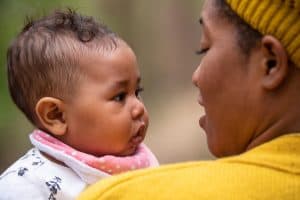The intricate links between SLCD and PSED
by Kirstie Page on December 8
7 min read:
Within the Early Years Foundation Stage Curriculum, there has always been a tendency to separate Communication & Language Development (C&L) from Personal, Social & Emotional Development (PSED) into different Areas of Learning. This continues to be the case following the EYFS Reforms. In some ways, this separation can focus our thoughts. However, it can also pull us away from understanding and considering the deep and intricate relationship between Speech, Language & Communication Development (SLCD) and PSED.
When we consider a child’s PSED, much of what we are looking at is SLCD. The PSED Observation Checkpoints within the new Development Matters give us a great chance to look more closely. We must, however, understand that these Checkpoints require many SLC skills to be in place if age-related expectations are to be met. This is particularly the case for fundamental Communication Skills allowing two-way interactions, Pragmatic Skills to allow social communication, Receptive Language Skills to allow understanding of what others say and Symbolic Skills to support the development of play.
Understanding the deep and intricate links between SLCD and PSED will allow us to use our thoughts about PSED to highlight and identify children with Communication and/or Language Needs. Interestingly, children with disordered patterns of development, particularly with slightly higher-level skills such as Pragmatics (Social Communication), Semantics (Vocabulary Skills,) along with Receptive Language Skills enabling abstract, non-literal and flexible understanding will, in some ways, be easier to identify within the PSED rather than the C&L Observation Checkpoints.
Supporting SLC Skills through our Targeted Practice will enable incremental, developmental progression with both PSED and C&L. Although these Areas of Learning are isolated on paper, they should not be isolated within our Practice as we embed interventions into our interactions, our daily routines and the way we use our learning environment. This is where a pure focus on child development in the Early Years can have a positive impact on learning and progression across the Curriculum.
To understand this deep and intricate relationship, let’s go back to the beginning…
Early attachments and relationships will be facilitated by babies having responsive adults in their world. Of course, adults need to respond to physical needs, but being responsive also requires lots of time and consideration when it comes to interaction. Spending lots of time engaged in face-to-face interactions, where adult and baby participate in early turn-taking routines, will allow the baby to tune-in to faces and voices, begin to learn the cause-and-effect process of communication and will, ultimately, pave the way for Speech & Language Skills. These interactions also pave the way for early bonds to be formed.
Babies with strong, early communication skills will seek out interactions earlier and offer more exaggerated and positive responses to adults. Ultimately, they are ‘easier’ to interact with. If adults are not careful, babies with strong skills get interacted with more, facilitating their development further. Babies who don’t begin to initiate interactions and who are less responsive, can, if adults are not careful, be interacted with less. This cycle should be avoided at all costs.
As a baby learns the cause-and-effect relationship about communication and the impact it can have on other people, signals that are sent out become gradually more specific and purposeful. At this point, there should also be an increase in the amount that the baby initiates interactions as a way of getting needs met, to gain attention or to simply seek out a communication experience from another person for its own sake. For example, after dropping something, a baby may look to the object and then look to the adult and then back to the object. If in doubt, the baby may vocalise or offer babble in order to further gain the adult’s attention and to make them realise that help is needed. At other times, the baby may make excited gross motor movements in order to indicate that they would like to be picked up. Before long, this will morph into a very specific movement such as raising both hands in order to indicate, “Please pick me up!”
More specific signals are fundamentally important when it comes to communication development as they allow the baby to establish a ‘joint point of reference.’ The emergence of pointing is seen as a very positive indication of this. Specific signals allow the baby to express what they need or are thinking about and also make sure that the very same thing becomes what the adult begins to think about too. This allows needs to be met, interests to be shared and interactions to begin. Through these interactions, language skills are built but, just as fundamentally, relationships are formed and bonds are made and maintained.
Without specific signals, it can be easy to talk to a baby or an older child about something that the adult thinks the child is interested in, but to get it wrong. This, therefore, means that the interaction is not underpinned by that joint point of reference. For language enrichment to be effective, language must match what is in the child’s head. That is why it is so crucial to follow a child’s lead and to stop, wait, watch and listen before adding language in those earlier stages of language development.
This continues to be crucial if a child is older but sends out fewer or less intentional signals. Establishing communication is the adult’s way of forming and building relationships with a child such as this. Of course, the adult is facilitating communication and language skills and ensuring progression from a ‘learning’ point of view. However, the PSED benefits of the focus on interaction should never be understated.
More specific signals, for most children, then become words and sentences. Of course, it is important to be aware of how many words a child understands and uses, along with how long their sentences become, considering whether the child’s language skills are developing in line with age-related expectations.
However, it is equally important to look at a child’s Pragmatic Skills, considering:
- Who does the child talk to?
- What do they talk about? Different things? The same thing?
- Why do they talk? Do they talk for different purposes or just to tell?
- Are conversations two-way? Is what the child says influenced by what others say and/or do?
 Although adult-child interactions are easier and more two-way when a child has strong Pragmatic Development, gaps here can particularly have an impact on establishing and maintaining relationships with peers. Does a child hover on the edge of a group because, despite stronger talk in other ways, they don’t know how to ask to join in or to have a turn? Within child-initiated provision, such skills should be modelled, coached and supported. By doing so, communication skills are facilitated which enable peer interactions to take place and for a child to work towards collaborative play.
Although adult-child interactions are easier and more two-way when a child has strong Pragmatic Development, gaps here can particularly have an impact on establishing and maintaining relationships with peers. Does a child hover on the edge of a group because, despite stronger talk in other ways, they don’t know how to ask to join in or to have a turn? Within child-initiated provision, such skills should be modelled, coached and supported. By doing so, communication skills are facilitated which enable peer interactions to take place and for a child to work towards collaborative play.
Although Communication and Pragmatic Skills can be the reason why some children stay on the edge of group play and interactions, the link between SLCD and behaviour also needs to be more fully understood. It may be that a child doesn’t know how to use language to ask for a turn or to join in, instead of staying on the side-lines, snatches and grabs to have a turn and to get what is wanted. If the child is slightly older but does not yet use words at all or only has a small vocabulary of single words, the link between behaviour and SLCN is clearer.
However, if, at other times, the child talks in sentences to tell you about one of their favourite topics, and then goes on to snatch and grab, it is very easy for adults to see this as a purer behavioural issue. To avoid missing the true, underlying issue, it is interesting to look at the child’s turn-taking skills, Receptive Language and Pragmatic Skills, such as whether the child uses language to initiate interactions and to ask. If there are gaps, how are these going to be addressed through Targeted Practice and Embedded Interventions?
Of course, behavioural issues will still need to be addressed in-the-moment. To do this effectively and fairly, the adult must be aware of the child’s language skills, most fundamentally, the child’s Receptive Language Skills. Knowing how much a child understands should inform adults about how they need to talk to that child as they support behaviour but at other times too.
As behaviour is supported and prompted, should very, very short simple phrases be used or can the child cope with slightly longer sentences? The main danger is that the adult says too much and swamps the child’s Auditory Memory with words. As a result, the message is lost. Does the child understand negative grammar? If not, when the child is prompted “Don’t splash Zak,” they hear “Splash!” If this is not known, it is essential that these things are found out to be effective and to avoid confusion or frustration on the part of the child.